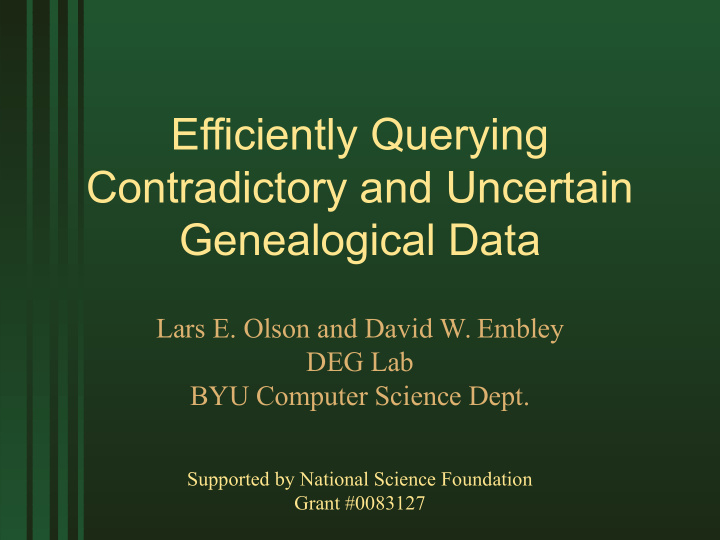



Efficiently Querying Contradictory and Uncertain Genealogical Data Lars E. Olson and David W. Embley DEG Lab BYU Computer Science Dept. Supported by National Science Foundation Grant #0083127
Introduction • Integrating data from multiple sources • Some data just doesn’t fit the data model – Multiple data sources conflicting data – Uncertain or imprecise data – Data that violates constraints • Sometimes it’s not possible to resolve the data • PAF / Gedcom 2
Disjunctive Databases “OR-tables,” Imielinski and Vadaparty, 1989 Name Birth Date Marriage Date Death Date 2 Feb. 1423 21 Feb. 1436 James I Dec. 1394 2 Feb. 1424 21 Feb. 1437 26 Jan. 1781 Joseph 26 Jan. 1782 19 Dec. 1811 5 Apr. 1861 Harrison 26 Jul. 1782 . . . . . . . . . . . . 3
Shortcomings of “OR-tables” • Can’t correlate between possible values First Name Surname Birth Place Purcell Cambridge Priscilla Loveridge Oxford • Answering queries in general is CoNP-complete (Imielinski & Vadaparty) 4
Sub-relation Data Construct • Solution: store the correlated data in its own relation First Name Surname Birth Place Priscilla Surname Birth Place Purcell Cambridge Loveridge Oxford 5
Disjunctive Database Problems • How do we avoid the CoNP-completeness problem and answer queries efficiently? • If more than one value is possible, which one is the most likely? • Other questions to be solved: – Where are the constraint violations? – How do we map sub-relations to physical storage? – How do we efficiently update the database? 6
Transitive Closure of Disjunctive Graphs Solving the CoNP-completeness problem [LYY95] Disjunctive graph Possible interpretation b b e e a c a c f f d d Transitive closure of a : { a , d , e } 7
Using Disjunctive Graphs to Answer Queries Birth Place ID# ID# Name Birth Date (references Marriage Date Table Person : Table Place ) 12 Mar. 1840 1 15 Jun. 1869 1 John Doe or or or 12 Mar. 1841 2 16 Jun. 1869 . . . . . . . . . . . . . . . ID# City State Table Place : Commerce 1 or Illinois Nauvoo 2 Quincy Illinois . . . . . . . . . 8
Using Disjunctive Graphs to Answer Queries π State ( σ ID=1 Person Place) Person John Doe Name ID# 12 Mar 1840 Birth Date 1 12 Mar 1841 Place Nauvoo ID# Marriage Date City 1 Birth Place Commerce State 15 Jun 1869 16 Jun 1869 State Illinois City ID# 2 Quincy 9
Using Disjunctive Graphs to Answer Queries π City,State ( σ ID=1 Person Place) …meaning what? – Definitely known? – All possible values? – Most likely value? Place Nauvoo ID# City City 1 City Person Commerce ID# Birth Place State Birth Place 1 State Illinois Birth Place City ID# 2 Quincy 10
Using Disjunctive Graphs to Answer Queries π City,State ( σ ID=1 Person Place) …meaning what? – Definitely known? – All possible values? – Most likely value? Place 1.0 Nauvoo ID# City 1 Person 0.2 Commerce ID# State Birth Place 1 0.8 State Illinois City ID# 2 Quincy Greedy Algorithm solution 11
Using Disjunctive Graphs to Answer Queries π P1.Name, P2.Name (Person P1 P1.BirthDate = P2.BirthDate Person P2) Person P1 John Doe 12 Mar 1840 Person P2 ID #1 ID #2 12 Mar 1841 James Doe 13 Mar 1840 12
Limiting the Search Space • In genealogy, most disjunctions are mutually independent • Disjunctions that aren’t independent are limited to immediate family relations • Build a relation containing all immediate family members (Person P1 P1.parent = P2.ID Person P2 P2.ID = P3.parent Person P3) 13
Limiting the Search Space • Example constraints: – Each parent should be born before their children – Each child should be born at least 9 months apart (except multiple births) Person P1 Person P2 Person P3 ID #1 ID #1 ID #1 1.0 ID #2 ID #2 1.0 ID #2 0.4 0.7 0.7 0.4 ID #3 ID #3 ID #3 0.6 0.3 0.3 0.6 ID #4 ID #4 ID #4 parent child = parent -1 14
Conclusions • Genealogical data can be stored in a disjunctive database format. • Many common queries can be computed in polynomial time. • We can detect intractable queries and limit the search space required, usually enough to get polynomial time. 15
Recommend
More recommend